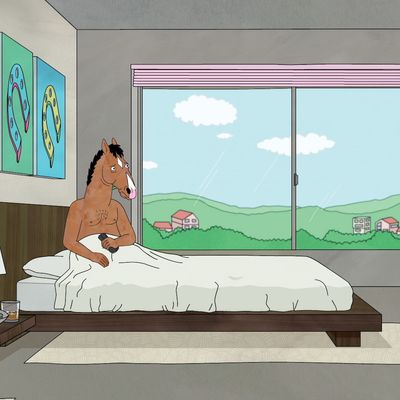
BoJack Horseman passes the first test of a great TV show: During the opening credits of every episode, you lean forward a bit, anticipating whatever it’s going to give you, simultaneously craving more of the stuff you already know that you like and material so audacious and just plain weird that you never could have seen it coming. With its mix of curveball innovations and very BoJack elements, season three of Raphael Bob-Waksberg’s cartoon sitcom set in a species-mixed world of humans and animals might be its best overall, though it necessarily lacks the aspect of jaw-dropping surprise that made it so beguiling in its first two outings. Following its self-destructive equine title character (Will Arnett) as he chases an Oscar for playing the lead in Secretariat, it seems rather keenly aware of itself: a series that doesn’t have just fans but students and that has become a dark-horse candidate (not sorry) for the title of hippest show on TV.
Now that we’ve had 25 episodes to get used to its methods, we start to anticipate where BoJack is going — realizing, for example, that the series wouldn’t play up BoJack’s growing frustration with his agent, the cat Princess Carolyn (Amy Sedaris), if their conflict weren’t going to come to a head, and that it wouldn’t mention the Labrador Peninsula, home of Mr. Peanutbutter (Paul F. Tompkins), if it weren’t going to send the dog and his human wife, Diane Nguyen (Alison Brie), there eventually, and that it wouldn’t bring back Sarah Lynn (Kristen Schaal), a former drug addict and probably sexual-abuse survivor who played BoJack’s daughter on his ’90s sitcom Horsin’ Around, if it weren’t setting her up for a hilarious-mortifying arc. But even as we congratulate ourselves on becoming attuned to its methods, its rhythms remain mysterious. One episode opens with a musical number; another segues from a childhood memory to a storybook-style cartoon-within-a-cartoon illustrating it, every image seemingly hand-painted. There’s even an episode set mainly at an underwater film festival where mammals have to wear diving helmets; the kooky ocean-floor send-up of life on land evokes Bikini Bottom in SpongeBob SquarePants (BoJack stays at the Rinse Carlton Hotel), and because BoJack can’t figure out how to speak with the helmet on, he resorts to gestures and handwritten notes, which gives the entire, rather melancholy episode a silent-movie feeling (specifically Chaplin). And then there are the moments where this deliberately ludicrous, five-jokes-a-minute show slams on its breaks and lets the characters (many of whom are emotionally broken, addicted to drugs or alcohol, or both) talk to each other as live-action, real-world people might. Some of these exchanges are treated as parentheses within the main action. Others get a more elaborate treatment: BoJack’s eventual throw-down with Princess Carolyn, a glorified two-hander set in a restaurant, might be this show’s equivalent of the classic Mad Men episode “The Suitcase.”
As on Mad Men, the hero’s cycles of self-destruction pull the entire story along in a hypnotic, often horrifying way. There’s no professional validation that will make BoJack happy, no amount of praise, drugs, booze, or sex that will fill the emptiness inside. Even if he wins the Oscar, he’ll still feel like a has-been and never-was. As Jeffrey Wright, the co-creator of a failed, arty sitcom starring BoJack, confesses: “I remember when I won my Oscar, standing up on that stage looking at the statue, thinking, ‘This is supposed to be the happiest moment of my life, but I never felt more miserable.’ ” “Oh,” BoJack says. “Because you’re sober?”
Despite its aesthetic ambitions and its willingness to go bleak and uncomfortable — “Not like funny hah-hah, more like funny Doonesbury,” as the horse hero puts it — BoJack Horseman still carries itself with a pretty light step. Good thing, too: The amount of delusion and self-destruction on display might prove unbearable if there weren’t so much silliness happening in the background and in the margins of shots. Many of the animal jokes constitute what might charitably be called “dad humor”: The bookshelf in Princess Carolyn’s office bears titles like Purrsepolis; a kangaroo bellhop produces a second bellhop from its pouch to help with bags; Mr. Peanutbutter hypes the Labrador Peninsula by telling Diane, “You’d love it up there — there’s so much to smell!”; a camel on a bar stool guzzles a pitcher of water to fill its hump; as a donkey family prepares to devour a hay bale in a restaurant, the mother tells her children, “Let us bow our heads and bray.”
Then there are moments that are merely absurd for absurdity’s sake, and would still be delightful even if they didn’t occur in a world where mammals, reptiles, amphibians, fish, birds, and insects all jockeyed for roles in Hollywood productions — such as Princess Carolyn trying to defend her profession to BoJack by holding up a tomato and explaining, “It’s like asking a really delicious tomato to make you a tomato sandwich. How’s he gonna make you a sandwich? He’s got no arms!” In BoJack’s world, this makes a surprising amount of sense.
*This article appears in the July 25, 2016 issue of New York Magazine.


